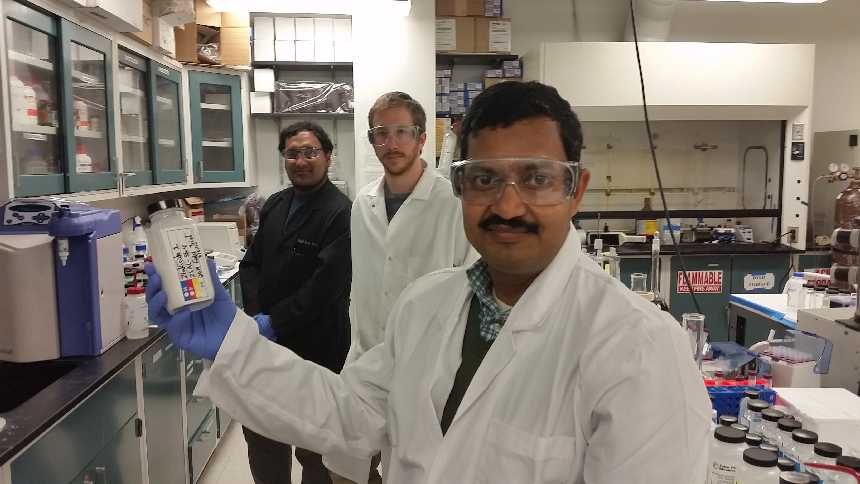Researchers Mine Nanotechnology To Help Conquer Citrus Canker

Associate professor Dr. Swadeshmukul Santra holds a sample of Zinkicide in his University of Central Florida nanotechnology lab.
Photo courtesy of UCF
In groves across Florida, citrus growers are collaborating at unprecedented levels, sharing ideas on producing citrus in the face of HLB. In labs and field trials, scientists also are working together with a sense of urgency brought on by the disease as it continues to reduce production.
The collaboration among scientists promises to bring benefits beyond the ultimate solution to HLB. One such example is the work of Dr. Swadeshmukul Santra, an associate professor at the NanoScience Technology Center at the University of Central Florida.
He has been working with Dr. Jim Graham, a soil microbiologist with UF/IFAS, to test a new zinc-based antimicrobial compound, which one day could provide a new level of canker control for citrus growers. Santra designed the product called Zinkicide using nanotechnology with the aim of creating particles so small they can penetrate the leaf surface.
Promising Results
Graham has been testing the product on trees beginning in the spring of 2014. “Trials proceeded through harvest,” Graham says. “I presented the results during the 2015 Florida Citrus Show and shared with the industry that Zinkicide does seem to have unique attributes in controlling canker at higher levels than we have ever seen.”
“The reason behind this superior activity with the product is that it appears to be locally systemic,” Santra says. “It forms a film just like copper pesticides, but it also penetrates the leaf, resulting in the improved activity. This is the beauty of nanoscience and nanotechnology.”
In field trials, Graham has tested the product sprayed on trees at agricultural rates. “We are not applying this material in a way that would be operationally demanding to growers,” Graham says. “We are spraying at similar rates and intervals. Because of its activity, our next steps will be to run trials to see if we can lower rates and extend the time between sprays. Anytime we can reduce the active ingredient and reduce the costs to growers, it is a good thing. That’s the goal.
“What we are really excited about is the idea we have gotten a metal inside the leaf without causing phytotoxicity. We don’t have the smoking gun evidence of that yet, but we are basically assuming the local systematic activity based on its performance controlling canker. And, zinc has much less risk of phytotoxicity when compared to copper.”
Regulator Friendly
While Zinkicide has several regulatory approvals to clear on its way to commercial availability, Santra was thinking ahead in his design of the product. “The beauty of this material is its components all are based on plant materials,” he says. “All the ingredients are natural and can be found in plants.”
In theory, this should help the material to be viewed more favorably by EPA when compared to some other antimicrobial materials.
Industry Stewardship
The development of Zinkicide is on track to be emblematic of industry cooperation to bring new products to growers more quickly. The Citrus Research and Development Foundation (CRDF) is playing a critical role in funding the development of the product, obtaining regulatory approvals (with FFVA), and eventually seeking out a commercial licensee.
“CRDF was established to focus specifically to discover and deliver solutions to HLB,” says Harold Browning, chief operating officer of CRDF. “About four years ago, we established the Commercial Product Delivery Committee, charged with facilitating the transfer of results to solutions.
“The current efforts to find bactericidal solutions to the HLB bacteria in infected trees, and specifically the evolution of zinc-based materials, demonstrates how CRDF is positioned to assist with identifying candidates to move forward to field trials, to identify potential partners to help bring the potential product(s) to market, and to assist in state and federal regulatory processes associated with delivering new tools.”
HLB Applications?
Santra also has his sights on developing a formulation of Zinkicide, which might be useful in targeting the HLB bacteria in the phloem of citrus trees.
“At the 2011 International Research Conference On HLB, we learned that the HLB bacterium is hiding in the phloem and it opened my eyes and got me motivated to seek solutions,” Santra says. “We are working on a special formulation for HLB. The compound size would have to be as small as the plant’s protein size.”
“This technology has ultimate goals, and let’s say we’ve reached goal No. 1 with a locally systemic metal, which is a big accomplishment,” Graham says. “It is a pretty tall order to have it move in the phloem and stay there with the requisite longevity.
“I joked that a systemic bactericide is like an oxymoron. But, Dr. Santra had a mind for developing one. He is a broad-thinking scientist to develop these nano-particles for deliver to very specific locations. It is good news we have innovative scientists like Dr. Santra out there working on growers’ behalf.”










